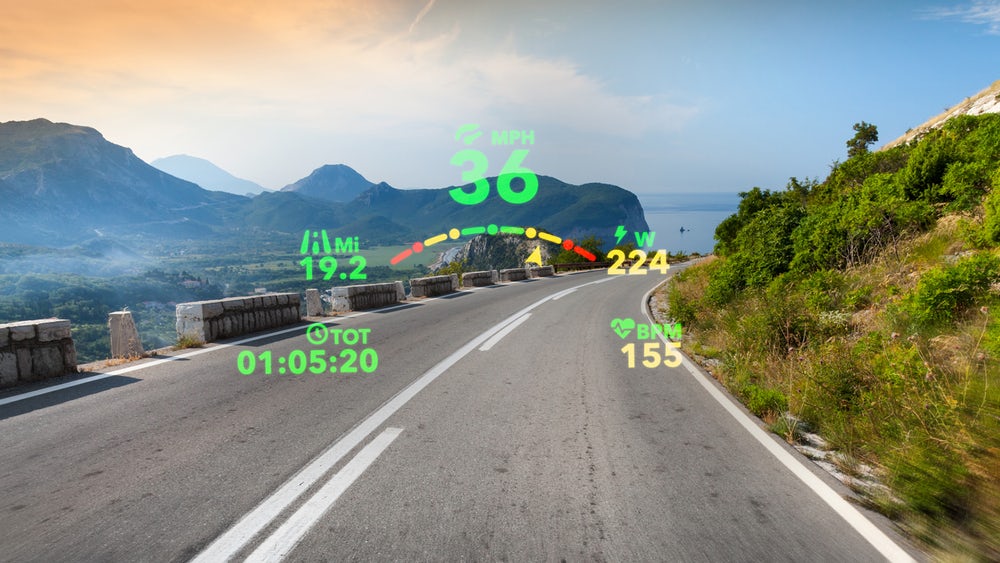
We’ve examined AR’s benefits in the enterprise, including a less-resistant buyer, a clearer return on investment, and sidestepping the biggest consumer barrier of all: Style. But it appears some of those advantages exist in another area: sports.
This is a principle behind Everysight. Its flagship Raptor glasses (beta) provide cyclists with heads-up visuals for vitals like like speed and direction. Images are projected onto, rather than displayed within a lens, which eases design considerations like style and aerodynamics.
“Google Glass had many faults but one of them was style,” Everysight CEO Asaf Ashkenazi told ARtillry. “That is something that we learned when people came back to us and said they had to be prepared to wear this on their heads. We call it the coolness factor. It has to be cool.”
As for specs (excuse the pun), Raptor runs on Android OS, a quad core CPU, 32 GB of internal storage, 2 GB of SDRam, and other components, like GPS, accelerometer and gyroscope. Touch controls line the side of the glasses or a handlebar-mounted pad, in addition to voice control.

Military Grade
Following a line of impactful products spun out of millitary applications (i.e. the Internet itself), Everysight is rooted in Israeli fighter jet technology. Its founding team and core technology hail from Elbit Stystems, which make 90 percent of heads up display (HUD) pilot helmets in use.
Despite AR’s more recent wave of interest and investment, Ashkenazi and team have been working with military-grade HUDs for about 22 years. But early on, they saw private sector opportunities for the underlying tech and began researching ways to bring it to market.
“One of the things we understood from the companies we worked with was that sports is a very good entry market for AR,” said Ashkenazi. This led to an internal Elbit program for a consumer derivative of the technology, which eventually materialized into Everysight in 2014.
This early arrival to AR presented a few challenges. One was getting the underlying technology into a small and sleek enough package — a challenge that persists today, especially in consumer applications. Another challenge was simply the nascency of the AR marketplace.
“The problem was that we didn’t find a lot of companies that have talent and knowledge in AR,” said Ashkenazi. “So when you’re looking at the abilities in this company, you’ll see that they’re fully vertical. We control everything, from the optics to the design, the electronics going in.”
That challenge ended up producing a strength in the company’s ownership of most of the tech stack, and intellectual property. But now that other parts of the AR value chain are being filled in throughout today’s marketplace, the company could start to license that IP to developers.
“We’ve had many people approach us to open our platform to third parties, and we’re currently seriously looking into doing that,” said Ashkenazi, “so people will be able to benefit and enjoy Raptor beyond sports. But currently we don’t have any official announcement on that yet.”

Beyond Sports
Like other focused and vertically-oriented AR applications, there’s an opportunity to open the platform to development in other areas, thus deriving more value from it. Ashkenazi and team are thinking no different: Android makes it adaptable, and the core technology makes it applicable.
“Having a system that’s a moving computer that knows where you are and where you’re looking, you can do navigation, tourism, museums, or any information in the scenery,” said Ashkenazi. “It’s like an iPad: There are uses for that Apple never thought there would be.”
As for platform advantages, there are IP strengths mentioned above but a particular point of differentiation is outdoor use. Raptor was meant to shine (literally) outdoors, compared to most AR glasses built for indoor use. This is a technical feat and rarity, given brightness and battery life.
Other technical challenges include the same limitations all AR players face, such as component size and cost. Some of these technologies are governed by Moore’s law, meaning the natural pace of chip-based tech advancement will support Raptor’s evolution over time.
But it also comes down to consumer education. Like with VR, the visceral experience is its advantage and disadvantage. People who try it are convinced immediately of its value and user experience… but you have to try it first, which presents a challenge in distribution.
“You’re fascinated by AR and so am I and there are others, but we are a small group today,” said Ashkenazi. “That group will become larger and larger when people really start to understand and appreciate AR. It took time for smartphones. It didn’t happen in one day.”

Open for Business
Speaking of educating consumers and getting the device into people’s hands, distribution is on Ashkenazi’s list of current business objectives. That includes mostly retailers: “To collaborate with retailers or other channels to help us distribute, that would be fantastic for us,” he said.
But Everysight mostly has its sight set on meeting the commitment to bring Raptor out of beta and fully launched in 2017. This has been Everysight’s promise to the market, and something Ashkenazi and team have been building towards for several years, and several design cycles.
“After 15 years of trying to have a consumer eyewear, this year it’s going to be there,” he said. “It’s like making a dream a reality.”
For a deeper dive on AR & VR insights, see ARtillry’s new intelligence subscription, and sign up for the free ARtillry Weekly newsletter.
Disclosure: ARtillry has no financial stake in the companies mentioned in this post, nor received payment for its production. Disclosure and ethics policy can be seen here.
